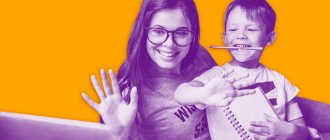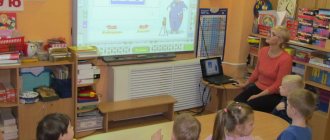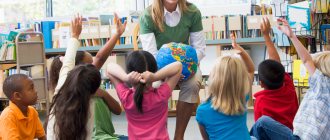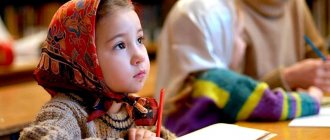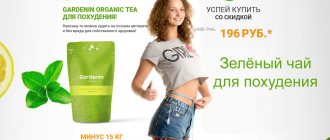Project “Joint creative activity of children and their parents in the educational process”
MUDO Center for Additional Education of Children in Avsyunino
Orekhovo-Zuevsky urban district, Moscow region
Project
“Joint creative activity of children and their parents
in the educational process"
The author of the project is a teacher of additional education
highest qualification category
Kuritsina Elena Konstantinovna
2020
“Joint creative activity of children and their parents
in the educational process"
The key task of modern state policy of the Russian Federation is to ensure the spiritual and moral development and education of the personality of a Russian citizen.
“Spiritual and moral development and education of the individual begins in the family. It is family values, acquired by a child from the first years of life, that are of lasting importance for a person at any age and form the basis of civil behavior in society.”
Parents play a vital role in a child's life. Parental love is the source and guarantee of human well-being, maintaining physical and mental health. That is why the first and main task of parents is to create confidence in the child that he is loved and cared for. Deep, constant psychological contact with parents gives the child the opportunity to feel and realize parental love, affection and care.
The basis for maintaining psychological contact is a sincere interest in everything that happens in a child’s life, sincere curiosity about his childhood, even the most trivial and naive, problems, a desire to understand, a desire to observe all the changes that occur in the soul and consciousness of a growing person. It is necessary to communicate with children from a young age: without communication, without constant concern for arranging common leisure time and common affairs with them, parents will not be interested in their own children.
The main values of educational activities in the system of additional education are the child, his development, childhood as the special life of a child, educational space as an environment conducive to personal development. Therefore, additional education has great potential to help parents establish and maintain psychological contact with the child, spiritual and moral development and education of all participants in the educational process.
One of the forms of interaction between additional education institutions and students’ families is family clubs and workshops. Organized joint creative activity is the inclusion of the parent in the child’s activity. This is a situation in which a child, faced with a certain difficulty, has the opportunity to turn to a parent for help. And the parent gets the opportunity to do the work together with the child. As a result of joint creative activity and common interests, the child and parent reach mutual understanding and become closer to each other.
Joint creativity with children. Why and how?
You can begin to engage in joint creativity with children from the moment the child can hold an object in his hands.
The type of activity of each individual child is determined by his age, individual rates of development, as well as his personal inclinations and preferences.
In the creative process, the following happens:
- Interesting and fruitful leisure time is carried out, which in itself is good as a type of positive habit.
- The desire to create develops.
- In the process of creativity, the child expresses himself, prevents psychosomatic diseases, expresses various emotions, works through feelings and states, such as fears (you can crush a plasticine wolf or tear a drawn one, and also give it positive traits), get rid of destructive tendencies and negative accumulations involuntarily received from society or in the process of internal growth, because there is no ontogenesis without pain.
- At the same time, there is a feeling of unity in common activities with the mother, a bringing together of realities, a sense of belonging, a common cause, a feeling of an adult’s interest in the baby’s affairs, a removal of the pressure of authority and the power of parents.
- Fantasizing and creative imagination are manifested, which is necessary for the harmonious development of the brain, which will be especially noticeable later, for example, when starting educational activities.
- The beginnings of creativity are formed, children think independently, creatively, not according to the proposed templates and schemes, they apply their own logic, obtained in the process of their work, and not gleaned from books or explanations of adults. It is very important!
- Creativity in all its forms allows children to unobtrusively develop such necessary functions as attention, memory, thinking, motor skills, and intelligence; I will describe in more detail how exactly this happens below, when I talk about examples of children's creativity.
- When working with natural materials, a feeling of unity with nature and respect for its gifts appears.
- When working with improvised means such as unnecessary boxes and jars, creativity develops, the child comes up with what can be made from a Hercules cereal box - a high-rise building, a car, a garage, a doll's crib, etc.
- In creativity, you can solve possible psychological problems and give vent to emotions. For example, if a child is going through a stage of age-related conservatism, then let the crocodile be green and angry; and if the baby is in a period of destruction of dogmas or fantasy, then the crocodile can be pink, live on a cloud and be kind. This will allow your things in the house to remain in their traditional places...
- Products of creativity can become participants in a role-playing game, heroes of a tabletop theater.
- A home exhibition of children's creativity develops in the child a sense of his own importance, value, personal abilities and skills.
- Creativity develops an aesthetic sense, taste and craving for beauty.
General rules
- Preparation of the workplace: cover the floor under the table with a large oilcloth, put pads on the table, prepare all the necessary materials and tools at once.
- Preparing children's clothing: dress your baby in comfortable clothes that you don't mind getting stained with paint or glue, or use a large apron with long sleeves.
- Use non-toxic and safe materials and tools whenever possible.
- When working with scissors, it is better to start with special children's safety scissors, while explaining how to use sharp objects and which end to apply them to. As soon as the baby masters these
- rules, you can switch to regular scissors, but it’s still strictly under your control. Under no circumstances should a child be left alone with scissors. Until then, cut out those parts that are inconvenient to cut with children’s scissors yourself using ordinary ones.
- Safety is very important, but children should not be completely deprived of the experience of handling sharp objects. It is necessary to explain from a very early age how to handle them, let them hold them, but never leave them alone. Let the baby carefully touch the point of a needle or knitting needle in your presence, let him learn the rules for handling them.
- It is better to take the glue in the form of a pencil and not very thick, so that the baby can apply glue to thin parts himself.
If you have several children of different ages, then you should distribute “responsibilities” in accordance with their age capabilities and personal preferences. For example, a child 4 years old and older (or mother) cuts out parts from paper, a child 2 years old and older smears them with glue, a child 1.5 years old and older applies them and smooths them out, a child 5 years old and older paints and works on small details, a child 6 years old months and older, finely tears paper (the scraps include snow, bird feathers, grass, etc.).- When practicing, you should take into account the child’s temperament, which determines the time he can continuously engage in one type of activity. Therefore, you should not expect perseverance from a mobile, active baby. In order not to discourage the desire to create, it is better to allow yourself to be distracted by other play activities or spend a physical minute or finger exercises with your baby, or be distracted by a light snack, if this does not contradict his regime and diet.
- The best work is the kind of creativity that the child himself was interested in carrying out. For example, a child saw a high-rise residential building with windows in an empty juice bag, or a tank car in a shampoo bottle, or a garage for a new toy truck in a gift mug box, or he himself noticed that pasta the shells are very reminiscent of a snail's house, and a little baby or a bunny will fall asleep perfectly in a box of processed cheese... The possibilities for children's creativity are limitless.
- In no case should you force a child if he does not want to do anything. If this is just a moment of temporary refusal from classes, then you can simply wait until the baby himself again shows a desire to create. If the rejection of creativity is systematic and stable, then first you can try to place the child in a group of children of a similar age who are enthusiastically engaged in creativity or simply have the mother do something at home. If this doesn't help, you can wait a while and try again. There is also always the opportunity to contact a professional child psychologist.
- During the process, it is strictly forbidden to scold the child for failures or carelessness. Even if the child glued something crookedly, you need to praise him for his work, for trying, for diligence, and be sure to note what he did best, because young children are not focused on the result, they work for the sake of the process. And then you can carefully say how next time you can improve some details that turned out worse. Sometimes you can return to unfinished work later. The finished work should be shown to all family members so that they can evaluate and praise the child. The child's work must be handled with care. It is better to put it on a shelf intended for displaying homemade children's creativity.
- It is better to start with what the child can definitely do. The first tasks should be obviously easier than the child could do. This will make him feel confident. Praise and admiration for his work is mandatory. Over time, when the baby understands that his actions are approved, you can complicate the tasks, introduce new elements; in more difficult cases, you can help the baby with something so that he does not feel inept. Help should be exactly the amount he needs. What the child can do on his own, let him do it himself.
- Under no circumstances be in the role of a teaching and edifying teacher. Just create together and have fun!
- At the end of the work, put things in order together, let the kids take the scraps to the trash bin, oilcloths and aprons to the bathroom, tools to their place, older ones can vacuum the room or take part in washing the bedding and oilcloths. To instill this habit of cleaning up after yourself, you should not punish or force it in a commanding tone, let it be the same game as the others. The main thing is to do everything together, while making jokes and smiling, and not grumbling.
- If children's work has accumulated so much that some of it needs to be thrown out, do it unnoticed by the child, otherwise you will devalue his work.
Examples
- Let's make a swamp. The basis is a disposable plate or circle made of thick cardboard. From the age of 1.5 years, a child rolls sausages from green dough (fine motor skills, sensitivity of the fingers and palm areas, and coordination of movements develop). From the age of 2.5 years, a child rolls sausages from plasticine and pastes the sausages over the edges of the plate (the same develops). All children decorate these edges with lentil grains (the same thing develops). Kids finely tear green paper (the same thing develops, and aggression and negative emotions are also brought out). Older children cut green paper with scissors. Everyone smears glue on the bottom of the plate and throws scraps of green paper there. The eldest (4 years or more) sculpts a frog from plasticine, makes eyes from halves of peas, cuts out a lily leaf from green cardboard, glues the leaf to the swamp, plants the frog, and makes a lily flower from a washed white and yellow napkin. The younger child rolls a sausage out of plasticine, the older one makes a snake’s face at the end of it, eyes can be made from grains of rice, and plants it in a swamp. The older child covers the match with green plasticine, creating a reed stalk. The kid rolls a brown sausage, it turns out to be the top of the reeds, cuts out a sheet of reeds from green paper and inserts the reeds into the chestnut hummock, the hummock with the reeds is glued to the swamp using glue or plasticine. Several snails are made from pasta shells; the younger one rolls a few sausages, the older one pulls out his horns, the bodies are covered with pasta and go down into the swamp. If desired, you can make several brown plasticine bumps into which broken matches or sticks are pressed. And the charming swamp is ready, then everything depends on your imagination.
- If you brought shells from the sea, then you can make the sea in approximately the same way. Sea pebbles are glued on, trimmings and scraps of blue paper, plasticine starfish decorated with grains, lobsters, plasticine crabs placed in your shells, fish made of colored paper or foil are also used.
- Chestnuts and autumn leaves offer endless possibilities for creativity. Hedgehog: the chestnut is covered with plasticine, the muzzle and legs are stretched out, needles are stuck from broken matches, eyes and a nose are made from grains, mushrooms and berries are made from plasticine on the back. Any animals are obtained by joining chestnuts with the help of matches, the necessary parts are made of plasticine, tails and feathers are made of colored paper. The owl can be placed in the hollow of a small plastic water bottle, and instead of a cork, dried leaves can be inserted on top - the foliage of a tree.
- You can make pictures by gluing matches and grains onto cardboard on which plasticine is smeared. From simple house figures for toddlers to complex ornaments and plots for older children.
- Almost anything can be made from empty juice boxes or rolled oats. The older child cuts out the sides of the house from colored paper, the baby coats them with glue and attaches them to the box. The eldest cuts out windows from yellow paper, the little one smears them with glue and sticks them on the house. The eldest then draws your family members in the windows, chandeliers, flowers on the window sills, curtains - whatever he deems necessary. You can make a fire escape out of matches and glue it to the house, and put a plasticine cat or little sparrows on the roof. Cars are also made, round wheels are cut out of cardboard, passengers are made of plasticine or drawn in the cabin windows.
- Wardrobe: a “book” is cut out of colored cardboard, and things are cut out from fashion or advertising magazines. Even a 1.5 year old child can handle this game.
- Many things can be made from cotton wool; snowy landscapes on plasticine, or just on a piece of cardboard, a beard for Santa Claus, a fur coat for a hare or cat, etc. You can make colored cotton wool, for example, for a fluffy yellow chicken, by sharpening the leads of colored pencils onto the cotton wool, or diluting gouache with water and spraying the craft like indoor flowers from a spray bottle.
- You can make both flat and three-dimensional figures from salt dough. Take 2 parts flour and 1 part salt, add water and knead into a tight dough. If you add dyes to the water, the dough will be colored; you can use gouache, juices and spices (for example, yellow turmeric). This way you can get any shade.
- On a plane, a green Christmas tree with colored toys looks beautiful. Three-dimensional figures need to be dried, then, if desired, you can additionally paint them with gouache, draw details, for example, the eyes of birds, the relief of feathers, etc.
- Caps from children's toothbrushes (cats, dragons, etc.) can serve as blanks for making figurines by adding acorns, matches and plasticine.
- In many creations, you can use toys from Kinder Surprises, and the plastic containers themselves can be eggs, barrels, pebbles, and animal bodies.
- You can build a living room in the lid of a cake box. Furniture can be made of colored cardboard. The residents can be made from toys or plasticine, bedding can be made from handkerchiefs or shreds, and dishes can be made from plasticine.
- Children love to give a second life to their broken toys. For example, a ladder from an old fire truck can be attached to a cardboard truck. Broken off wheels will be useful when making a car from a plastic shampoo bottle. Crumpled tennis balls can become clown heads (they can be easily decorated with felt-tip pens). From a lipstick case you can make a pipe at home, a bench, etc.
- Measuring cups for medicinal syrups are stumps in the forest, stools, tables, baskets, buckets and hats. Glued together empty matchboxes are houses, planes, cars.
- I personally collect all such potential materials in a shoebox; laces, buttons, boxes, bubbles, etc. When the idea to create something arises, the children and I take out this box and always find the necessary parts.
Yulchatka's blog
Joint creativity between children and parents is necessary for both parties. We, adults, really lack vivid images, but children can create them, because they do not know how to convey their impressions of the world around them in any other way. I am only now beginning to criticize my daughter’s work, thereby showing that not everything that Svetlana creates is a masterpiece. But I don’t impose my opinion, so as not to interfere too much with the process of expressing feelings and thoughts. I noticed that my child’s creative activity awakens at the time when I myself begin to make something. Imitating my actions, my daughter creates her own unique things. Today I will show some of our drawings, created by either one or the other of us, or sometimes by both of us.
For the drawing “ Egyptian Eye ” we used the following materials: watercolor paper, gouache, washing powder, water.
In order for a child’s activity to be creative in nature, it is necessary to offer him as often as possible various materials for creativity that he would not even think of using.
Notice how boring and clear the lines are in my drawing (top), and how interesting the chaotic lines drawn by Svetlana are (bottom). And my daughter’s drawing of a dragonfly delights me:
Materials used: watercolor paper, oil pastels, wax crayons.
Who, besides us, parents, knows for sure what is interesting to our children, what experiences will captivate them and what will not, what new knowledge they will acquire and then apply in their creativity. For example, we saw a photo of a platypus in a magazine and decided to depict it. It is clear that the drawing will not be identical to the photograph. That's why we chose the brightest colors and decorated our sweetly dozing platypuses with cheerful dots. This is how our drawing turned out using cotton swabs and a black pen (the artist Sergei Merkulov will teach you how to draw with it).
Materials used: colored cardboard, black gel pen or thin marker, gouache.
It should also be taken into account that the perception of children is sensory (I think that this word will be the most appropriate), because for them it is important to see, touch, feel, that is, to experience the world, and visually. To create a subtle atmosphere of creativity, the child must be given freedom, and the parents must remain patient and delicate.
This drawing was made with oil pastels , and the feathers were drawn with a soft-hard pencil.
Personally, I, and many parents, I think, by getting involved in children's creativity, they themselves acquire practical skills, which makes the joint creativity of children and parents very fruitful. Here are my drawings. They may seem primitive and flat to you, but I made them according to my daughter’s sketches.
In the drawing on the right, in addition to oil pastels, I also used pearlescent watercolors.
During walks together and then, sitting comfortably at the table, my daughter and I often enthusiastically draw. Such closeness, like communication, is valuable, because nothing brings us closer than spending time together.
We never forget about our mood vitamins, obviously, that’s why we used expired multi-colored tablets that we didn’t dare throw away. So drawing of a magic tree with funny faces turned out:
And I just have colored fruits:
And you probably already noticed a flower with a tablet core in the first photo of this post.
As they say: “The process has begun!” and my help was no longer needed at all, I just sat side by side and scribbled sketches on a sheet of paper. But my daughter came up with it and implemented it. This is a flower meadow with a sun in the shape of a cow’s face:
And this is a dog that won an exhibition of its own kind:
What would it be like without a ferret (drawn with colored pencils):
There were also marine and ship themes (however, this drawing was created last summer, but I decided to include it in the review of works):
And we created this work on canvas together (I painted the raging sea) after visiting the exhibition “Scarlet Sails”:
Another drawing of a magic tree reminded me of an image from the paintings of artist Maria Trudler, whose blog my daughter watched with me some time ago. Apparently, the amazing lines sunk into her soul that she decided to put them on paper.
The additions in the form of splashes of happiness and gilding of the tablets are mine.
I also did the curls in the corners, because I don’t like empty spaces.
Almost all psychologists say that it is necessary not only to create together with children, but also to organize exhibitions of joint creativity. So today I did one of these. I hope you liked it and you will also be carried away by this idea. After all, by developing the creative abilities of our children, we help them explore the world of miracles, goodness and beauty.
Thank you for watching and reading my post to the end, it means you care!
... If you want to read me always and know when the blog is updated with new materials, subscribe to the news “ BY CLICKING HERE ”
Does my child need creativity?
You decide.
Just take it for granted:
Firstly, creativity is directly related to motor skills:
- Developed motor skills → developed speech.
Secondly, preschoolers think in images, unlike adults:
- More images → better mental development.
- Developed imaginative thinking → developed imagination.
- Developed imagination and fantasy → non-standard train of thought and unconventional thinking.
- Unconventional thinking → successful advancement in life.
Thirdly, creativity is a way through which children can express their emotions, experiences, and establish their own importance.
Of course, creativity is not a pill for all problems. But one of the foundations of harmonious education. Harmony of the body and harmony of the spirit are laid down with creativity, among other things. We are designed in such a way that we are drawn to beauty and we have the power to show this beauty to our children.
Vikiland photo reports
We host many interesting events for children and adults!
View all photos
Return to list
Joint creative activities between parents and children
To choose a lesson
It is better to start engaging in creative activities as early as possible. Ideally, this should be done when the baby begins to confidently hold small objects.
Creative interaction between mother and baby makes up for the lack of attention taken away from the child by the crazy rhythm of modern cities and the never-ending work of his mother. It relieves the pressure of parental authority and helps the child express himself and realize his importance in the family and the world.
A child who has received a lot of space to realize his imagination allows himself to think outside the box. At first, when he sees ordinary objects, he will begin to have unique, bold associations, then he will delight you with an original approach to solving various problems at school or a creative birthday surprise in the form of a beautiful wall newspaper or collage made by his hands.
Joint creativity should not be accompanied by negative emotions, so you need to prepare for them very thoroughly. At a minimum, you need to know in advance what items you will need during the work. After all, leaving a child alone with glue or scissors and going off to look for the missing tool is not the most reasonable solution.
To make your task easier, we are ready to offer you various courses and master classes in which you can take part with your children. Our family center in the center of Moscow is located in a convenient area, and all our activities are varied, exciting and lively!
